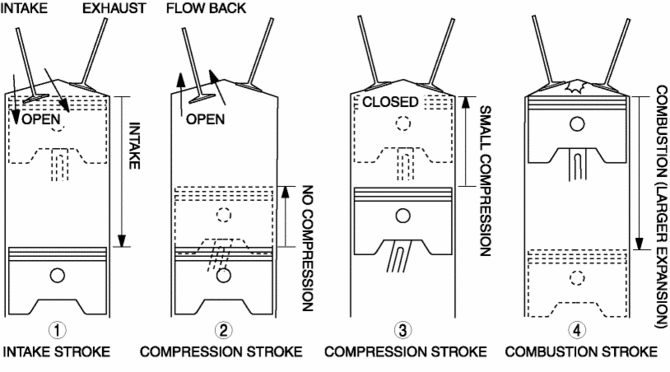Mazda CX-5 Service & Repair Manual: Miller Cycle Engine
Outline
-
The Miller cycle engine is a high-efficiency engine which achieves high fuel economy performance by obtaining a high-expansion ratio.
-
The Miller cycle engine achieves a high-expansion ratio without increasing its effective compression ratio by retarding the intake air valve close timing.
Operation
1. Intake air is introduced into the cylinder.
2. The intake valve is kept open after the intake stroke is finished to force the air in the cylinder to flow back to the intake pipe.
3. The compression stroke starts from the position in which the intake valve is closed (small compression).
4. The air-fuel mixture is combusted and the piston is pushed down to BDC (large expansion).

 Mechanical
Mechanical
Outline
The sliding resistance*1 has been reduced by:
the adoption of a rocker arm (built into needle roller bearing)
reducing load on the valve spring
narrow ...
 Non Return Valve Inspection
Non Return Valve Inspection
WARNING:
Fuel is very flammable liquid. If fuel spills or leaks from the pressurized
fuel system, it will cause serious injury or death and facility breakage. Fuel
can also irritate skin ...
Other materials:
Front Door Module Panel Removal/Installation
1. Perform the front door glass preparation..
2. Disconnect the negative battery cable..
3. Remove the following parts:
a. Inner garnish.
b. Front door trim.
c. Front door speaker.
d. Front door glass.
NOTE:
After removing the front door trim, secure the inner handle using scre ...
Control System [Manual Air Conditioner]
Outline
Refrigerant pressure sensor adopted in which refrigerant pressure is changed
into a linear electric signal and precise information is transmitted.
Climate control unit with enlarged operation dials and switches adopted
Structural View
System Wiring Diagram
...
Room Straight Line Dimensions (3) [Dimensions]
Point symbol
Designation
Hole diameter or bolt or nut size mm {in}
A
Rear seat installation hole
?14 {0.55}
B
D-pillar trim installation hole
?8.6 {0.34}
...
